History and description
A palace at the site was built by the noble Tornambene family in the 15th century. It was only two stories high. In 1505, it was sold to the Baron of Sigona, Alvaro Paternò and his wife Isabella. Like nearly all construction in Catania, it was mostly destroyed by the 1693 earthquake although the palace had been built against the medieval walls of the town, that withstood the tremor and can still be seen along via Santa Teresa. Antonio Paternò, 6th Baron of Manganelli, commissioned the construction of a new palace from Alonzo Di Benedetto and Felice Palazzotto.
In 1837, a severe cholera outbreak in Catania caused a short rebellion by the populace, who protested in front of this palace, home of the then Catanian governor, the prince of Manganelli. [2] They demanded the appointment of a new sanitary commission. In 1860, the Garibaldini, during their successful conquest of the Neapolitan kingdom, sacked the palace, destroying or looting the contents. In 1873, the level of via Sangiuliano was lowered, requiring further reconstruction, including the addition of the third floor. In the 1870s, the piano nobile was decorated with frescoes by Giuseppe Sciuti and Ernesto Bellandi, working on commission from Princess Angela Paternò di Manganelli Torresi. [3]
In the 20th-century, the palace was inherited by the Borghese family, upon the marriage of Donna Angela Paternò, 7th Princess of Sperlinga of Manganelli, to Don Flavio Prince Borghese, 12th prince of Sulmona. The descendants still live in parts of the palace. [4]
The facade has a playful decorative program, with brackets for the balconies decorated with faces. The portal is profusely decorated with female atlantids and cherubic figures flanking a crowned coat of arms. Also notable in the palace is the pocket garden to the rear (East) of the facade, entered from the palace. The crowded center of Catania has little such greenery. It occupies two levels and has fountains and a nymphaeum. Some of the greenery can be viewed spilling over the old city walls on Via Santa Teresa.
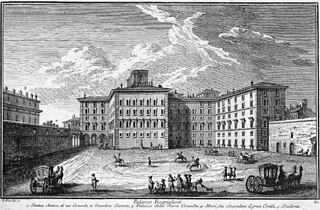
The Palazzo Pallavicini-Rospigliosi is a palace in Rome, Italy. It was built by the Borghese family on the Quirinal Hill; its footprint occupies the site where the ruins of the baths of Constantine stood, whose remains still are part of the basement of the main building, the Casino dell'Aurora. Its first inhabitant was the famed art collector Cardinal Scipione Borghese, the nephew of Pope Paul V, who wanted to be housed near the large papal Palazzo Quirinale. The palace and garden of the Pallavicini-Rospigliosi were the product of the accumulated sites and were designed by Giovanni Vasanzio and Carlo Maderno in 1611–16. Scipione owned this site for less than a decade, 1610–16, and commissioned the construction and decoration of the casino and pergolata, facing the garden of Montecavallo. The Roman palace of this name should not be mistaken for the panoramic Villa Pallavicino on the shores of Lake Como in Lombardy. The Palace has also been the scene of important cultural and religious events. On June 6, 1977 Princess Elvina Pallavicini invited in Palazzo Pallavicini Rospigliosi the archbishop monsignor Marcel Lefebvre for a conference on the Second Vatican Council and for the celebration of a Traditiona Mass, under the careful direction of the marquis Roberto Malvezzi, and Frigate Captain marquis Luigi Coda Nunziante di San Ferdinando. Many members of Alleanza Cattolica, the baron Roberto de Mattei, the pharmacologist Giulio Soldani, the sociologist Massimo Introvigne, the psychiatrist Mario Di Fiorino and Attilio Tamburrini and his brother Renato Tamburrini took part to the event.

Duke of Carcaci is a title in the Kingdom of Sicily, held by the head of one branch of the House of Paternò, a major Sicilian noble family.

Palazzo Borghese is a palace in Rome, Italy, the main seat of the Borghese family. It was nicknamed il Cembalo due to its unusual trapezoidal groundplan; its narrowest facade faces the River Tiber. The entrance at the opposite end of the building, the "keyboard" of the cembalo, faces onto the Fontanella di Borghese, with another in a great flanking facade to the Piazza Borghese that is extended by a slightly angled facade leading down Via Borghese towards the river. Both these entrances lead into a large courtyard on one side of which is a two level open arcade, with paired Doric and Ionic columns, that frames the garden beyond.

The Palazzo Biscari is a monumental private palace located on Via Museo Biscari in Catania, Sicily, southern Italy. The highly decorative interiors are open for guided tours, and used for social and cultural events.

San Benedetto is a late-Baroque architecture, Roman Catholic church and former Benedictine monastery in the city Catania, Sicily, southern Italy. The church facade faces Via Crociferi, parallels across via San Benedetto the former-Jesuit church of San Francesco Borgia, and both are about a block south along Crociferi from the church and convent of San Giuliano. Entrance to church and monastery appear to be through Piazza Asmundo #9 near the apse of the church.

The Palazzo Tezzano is a monumental palace in Piazza Stesicoro, in the center of Catania, Sicily, southern Italy. The via Etnea, with prominent shops, bisects the Piazza; this palazzo rises at the northwest intersection with this via, across from the white stone, neoclassical Palazzo Paterno del Toscano.

Piazza d'Aracoeli is a square of Rome (Italy), placed at the base of the Capitoline Hill, in the Rione X Campitelli.

The Baths of the Rotonda are the remains of one of several Roman public baths in the city of Catania, Sicily. Built between the 1st and 2nd century CE, they are not far from the Roman theatre and the odeon. In the Byzantine era, the church of Santa Maria della Rotonda with its characteristic dome was built upon the remains of the Roman baths. Its walls are still covered in medieval and baroque frescoes.

San Placido is a Roman Catholic church and former-Benedictine monastery located on the piazza of the same name in Catania, Sicily, southern Italy. The complex, two blocks east of the Catania Cathedral, spans a polygonal block encompassed by the Via Vittorio Emanuele II on the north, the via Landolina to the east, the via Museo Biscari on a south diagonal, and to the west the piazza San Placido and Via Porticello. Part of the convent is occupied by the Palazzo della Cultura, used for cultural activities and exhibitions. The Monastero di San Placido also serves presently as the Archivio di Stato di Catania.

Santa Agata al Carcere, sometimes called Santo Carcere or the Carcere church is a Roman Catholic church located on Piazza Santo Carcere #7, in the city of Catania, Sicily, southern Italy. It is one of three nearly adjacent churches venerating St Agatha of Sicily in this neighborhood, the other two being Sant'Agata alla Fornace and Sant'Agata la Vetere.
Santa Chiara is a Roman Catholic church located on Via Garibaldi #100 in the center of the city of Catania, Region of Sicily, Italy. The monastery located behind the church presently houses a gallery of modern art.
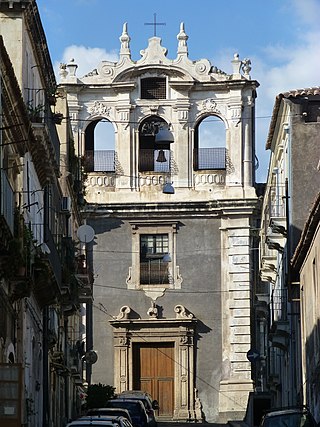
The Conservatorio delle Verginelle di Sant'Agata is a former orphanage-hostel and church located on via Teatro Greco #82, with the northern facade paralleling Piazza Dante and the Monastery of San Nicolo l'Arena in the center of the city of Catania, region of Sicily, Italy. Presently it houses the facilities of the Faculty of the Scienza della Formazione of the University of Catania, educating future science teachers.

The Roman Theatre of Catania consists of the ruins of two open-air semicircular ancient Roman theatres, located between Piazza San Francesco, via Vittorio Emanuele, via Timeo, and via Teatro Greco in the center of Catania, Sicily, southern Italy. The site consists of a larger theatre and a smaller semicircular theatre, an Odeon. The structure is part of the Parco archeologico greco-romano di Catania.
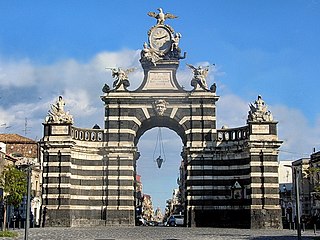
The Porta Garibaldi, originally built as the Porta Ferdinandea or Porta Ferdinanda, is a triumphal arch, built in 1768, located at the end of Via Giuseppe Garibaldi, between the Piazza Palestro and Piazza Crocifisso in the quartiere Fortino of Catania, region of Sicily, Italy. It was built to celebrate the marriage of the Bourbon king Ferdinand I of the Two Sicilies to the Austrian princess Maria Carolina d'Asburgo-Lorena.

San Domenico, also called Santa Maria la Grande is a Roman Catholic church and active convent located on piazza San Domenico in the quartiere di Santa Maria la Grande, in Catania, region of Sicily, Italy. The church stands about two blocks north of the church of Sant'Agata la Vetere on via Santa Maddalena. The neoclassical-style, late 17th-century church houses a few prominent altarpieces that survived the 1693 catastrophe in Catania.

Santa Teresa, also called Santa Teresa del Bambin Gesú or Bambino Gesú is a Roman Catholic parish church and Discalced Carmelite cloistered convent, located on Via Antonino Di Sangiuliano #219, at the intersection with via Santa Teresa, in Catania, region of Sicily, southern Italy.

The Palazzo Paternò del Toscano, also known as the Palazzo del Toscano, is an notable palace in Piazza Stesicoro, in the center of Catania, region of Sicily, southern Italy. The building now houses many shops, but is also used by schools, and for cultural programs. The white stone facade stands before the Monument to Vincenzo Bellini and rises in contrast to the palace across via Aetna, the white and black Palazzo Tezzano.
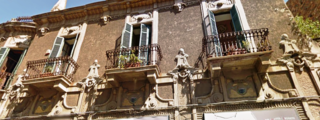
The Garage Musumeci is an notable building, elaborated in a flamboyant Liberty style, and built to house both an automobile showroom on the ground floor and above the apartments of the owner, Baron Musemeci. It is located in Piazza Bovio, at the intersection of Via Conte di Torino and Via Francesco Crispi, in the city of Catania, region of Sicily, Italy.
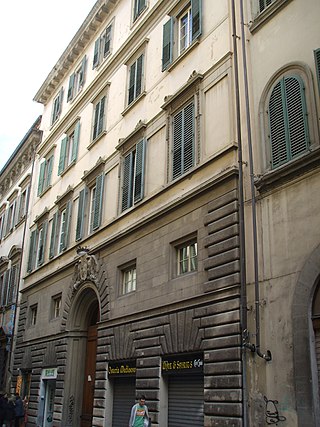
Palazzo Borghese-Aldobrandini is a building in Florence, located at via Ghibellina 123.




















